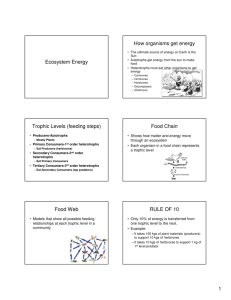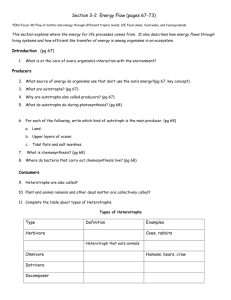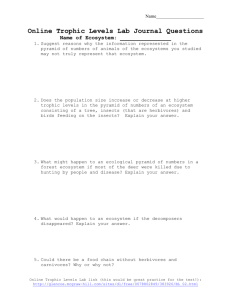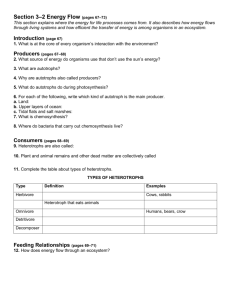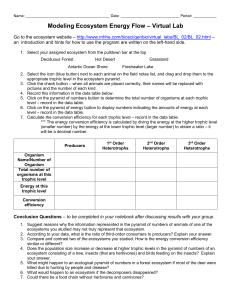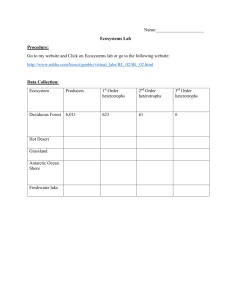Model Energy Pyramid Virtual Lab PAP
advertisement
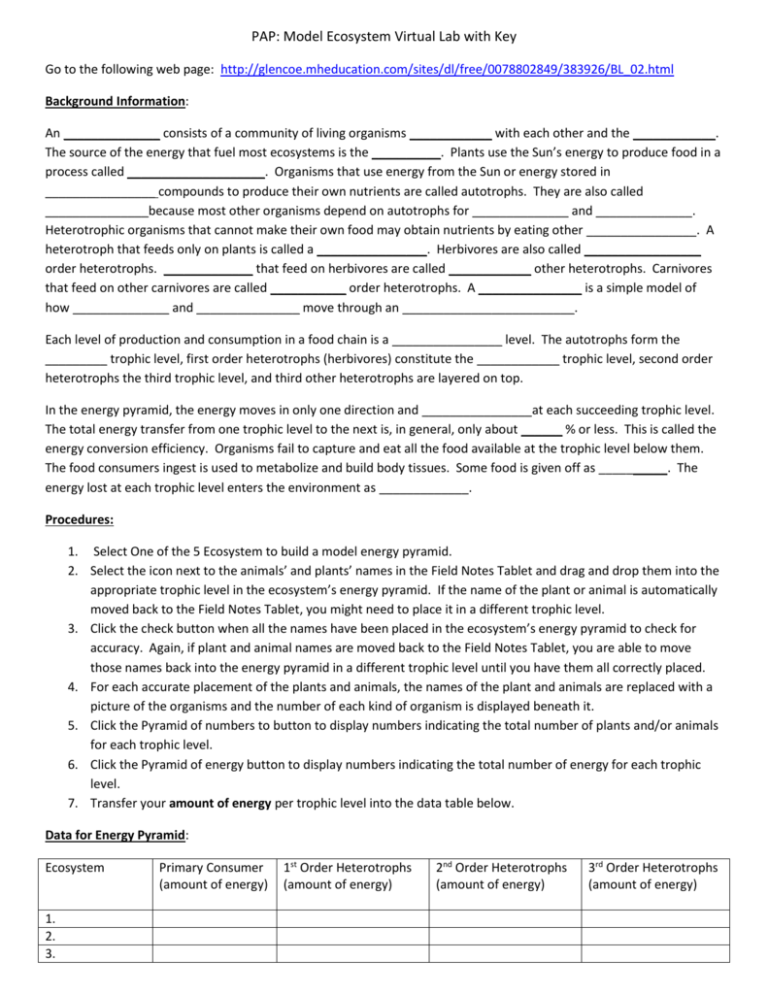
PAP: Model Ecosystem Virtual Lab with Key Go to the following web page: http://glencoe.mheducation.com/sites/dl/free/0078802849/383926/BL_02.html Background Information: An ______________ consists of a community of living organisms ____________ with each other and the ____________. The source of the energy that fuel most ecosystems is the __________. Plants use the Sun’s energy to produce food in a process called ____________________. Organisms that use energy from the Sun or energy stored in ________________ compounds to produce their own nutrients are called autotrophs. They are also called _______________because most other organisms depend on autotrophs for ______________ and ______________. Heterotrophic organisms that cannot make their own food may obtain nutrients by eating other ________________. A heterotroph that feeds only on plants is called a ________________. Herbivores are also called _________________ order heterotrophs. _____________ that feed on herbivores are called ____________ other heterotrophs. Carnivores that feed on other carnivores are called ___________ order heterotrophs. A _______________ is a simple model of how ______________ and _______________ move through an _________________________. Each level of production and consumption in a food chain is a ________________ level. The autotrophs form the _________ trophic level, first order heterotrophs (herbivores) constitute the ____________ trophic level, second order heterotrophs the third trophic level, and third other heterotrophs are layered on top. In the energy pyramid, the energy moves in only one direction and ________________at each succeeding trophic level. The total energy transfer from one trophic level to the next is, in general, only about ______ % or less. This is called the energy conversion efficiency. Organisms fail to capture and eat all the food available at the trophic level below them. The food consumers ingest is used to metabolize and build body tissues. Some food is given off as __________. The energy lost at each trophic level enters the environment as _____________. Procedures: 1. Select One of the 5 Ecosystem to build a model energy pyramid. 2. Select the icon next to the animals’ and plants’ names in the Field Notes Tablet and drag and drop them into the appropriate trophic level in the ecosystem’s energy pyramid. If the name of the plant or animal is automatically moved back to the Field Notes Tablet, you might need to place it in a different trophic level. 3. Click the check button when all the names have been placed in the ecosystem’s energy pyramid to check for accuracy. Again, if plant and animal names are moved back to the Field Notes Tablet, you are able to move those names back into the energy pyramid in a different trophic level until you have them all correctly placed. 4. For each accurate placement of the plants and animals, the names of the plant and animals are replaced with a picture of the organisms and the number of each kind of organism is displayed beneath it. 5. Click the Pyramid of numbers to button to display numbers indicating the total number of plants and/or animals for each trophic level. 6. Click the Pyramid of energy button to display numbers indicating the total number of energy for each trophic level. 7. Transfer your amount of energy per trophic level into the data table below. Data for Energy Pyramid: Ecosystem 1. 2. 3. Primary Consumer (amount of energy) 1st Order Heterotrophs (amount of energy) 2nd Order Heterotrophs (amount of energy) 3rd Order Heterotrophs (amount of energy) How well does energy transfer from one trophic level to the next? In order to answer that question, you will complete a “conversion efficiency” between each trophic level. To do this you will divide the energy at a higher energy level by the amount of energy at the trophic level directly beneath it. Example: 1st Order Heterotrophs (amount of energy) Primary Consumer (amount of energy) Ecosystem 744 Units of energy 7,500 Units of energy 0.992 1st Order Heterotrophs (amount of energy) 2nd Order Heterotrophs (amount of energy) 3rd Order Heterotrophs (amount of energy) Primary Consumer (amount of energy) 1st Order Heterotrophs (amount of energy) 2nd Order Heterotrophs (amount of energy) 1. 2. 3. What patterns are beginning to emerge? What are you observing as the efficiency of energy from one trophic level to the next? If you round-off your numbers above which of the following decimals numbers most closely matches ALL your numbers? A. 0.23 B. 0.10 C. 0.30 D. 0.01 This exercise shows you that ______% of energy from the lower level is available to the next level up. With this information, draw an energy pyramid. Be sure to label each trophic level. If a 100 Kcal, units of energy – measured in calories, are available at the 1st Consumer level, indicate how much energy would be available for the remaining trophic levels and the % of energy that is available at each level. Post Lab Questions: 1. Compare and contrast your ecosystems with another one presented in class. How is the energy conversion efficiency similar or different? 2. Does the population size increase or decrease at higher trophic levels in a pyramid of numbers for an ecosystem of a tree, insects (herbivores), and birds feeding on insects? Explain your answer. 3. What might happen to a forest ecosystem if most of the deer were killed due to hunting by people and disease? 4. What could happen to an ecosystem if the decomposers disappeared? 5. Could there be a food chain without herbivores and carnivores? Explain.

